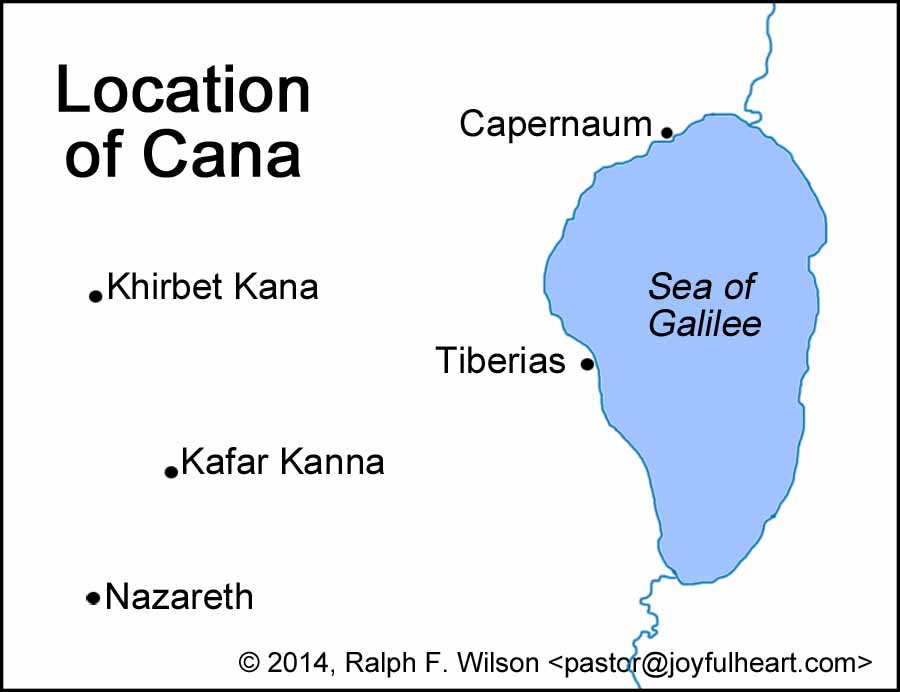- Do you like weddings? Why or why not?
- Read
LukeJohn 2:1-12 - CANA: Cana is in the vicinity of Nazareth, Jesus’ home town. While the location of Cana is not definitively known, you can see from the map below that it is no more than about 7 miles from Nazareth, about 2.5 hours walk (close enough that visiting for one day is not unreasonable).
- WEDDINGS: Weddings at this time were huge community affairs. The couple would be betrothed (a legally binding contract) while physical consummation was reserved for the wedding night. On the day/evening of the wedding, the groom would begin at his or his parents’ home and walk through the town to get his bride. Friends and family would be waiting along the way to join him. This would be a loud and joyful party with singing. The groom would get the bride from her home and they would walk back in a procession of ever growing numbers back to the groom’s (or groom’s parents’) home for the wedding ceremony. The couple would have a place of honor under a canopy during the wedding banquet after which they would depart physically consummate their marriage while the party went on. They would return and the party would continue. The wedding feast would last up to 7 days. More distant relatives and friends might leave early, but the close relatives and friends would stay for the entire 7 day feast. It was a great disgrace to not provide full and gracious hospitality during the wedding feast, in some writings likened to thievery.
- Read a prophecy about the restoration of Israel in Amos 9:11-15 and note how wine fits into this prophecy.
- “THEY HAVE NO WINE” Why does Jesus choose to intervene? Here are three possible forces at play. Which do you think was the strongest?
- The host would be disgraced.
- The feast would end early.
- His mom asked him to.
- What do you think of Jesus’ reaction to his mother? (You might want to read Jesus’ Parable of the Two Sons recorded in Matthew 21:28-32).
- Mary seems to assume that Jesus will respect her wishes even though he is a 30 year old male rabbi with a cadre of disciples. What does this tell us about Jesus’ relationship with his mother? Does this tell us anything about the commandment to “Honor your father and mother.”?
- There may be some symbolism in the six stone jars to be filled with water. Recall that water is the substance over which the Spirit of God hovers in Genesis 1:2 before creation begins. Then, in six days, creation is complete. Wine could be considered a “completed creation” product because a) it requires human involvement in its production, b) it is for enjoyment of man, and c) it is a feast drink, when the work is done. This also fits in with verse 11 of our text, where John writes that this is the “first” of Jesus’ signs. John labels another miracle the “second sign” (see John 4:54). Scholars have speculated that John constructed his Gospel around seven signs to indicate Jesus’ divinity in a literary way. The seven signs (in one view) end with the resurrection of Lazarus. The signs are, in order:
- Changing water into wine in John 2:1-11
- Healing the royal official's son in Capernaum in John 4:46-54
- Healing the paralytic at Bethesda in John 5:1-18
- Feeding the 5000 in John 6:5-14
- Jesus' walk on water in John 6:16-24
- Healing the man born blind in John 9:1-7
- Raising of Lazarus in John 11:1-45
- The text indicates that the wine Jesus made was consider by the master of the feast (who could certainly discern good wine from bad) to be excellent, the best wine of the feast. What might this teach us about God’s gifts and his desire for us?
- MANIFESTED HIS GLORY: “Manifest,” as a verb, means to “display or show (a quality or feeling) by one's acts or appearance; demonstrate.” What does this miracle show to you about Jesus?
- What else struck you?
- Close with prayer.
Monday, January 18, 2016
Commentary & Bible Study on JOHN 2:1-12 (Horrible typo in main Bible reference in blog. Sorry.)
Subscribe to:
Post Comments (Atom)


No comments:
Post a Comment